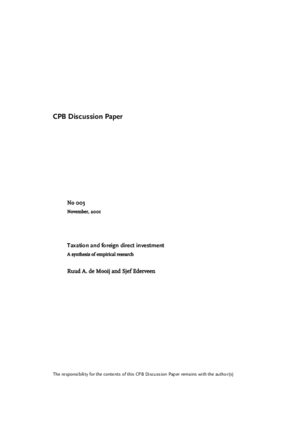Taxation and foreign direct investment; a synthesis of empirical research
Differences in company tax rates between EU-countries cause substantial distortions
On average, if a country reduces its effective tax rate on companies by 1%-point, it attracts an additional foreign direct investment of approximately 3.3%. There is, however, substantial variation of the responsiveness of investment depending on the type of investment considered and the tax rate.
This is the main conclusion of CPB Discussion Paper no. 3, Taxation and foreign direct investment: A synthesis of empirical research, written by Ruud de Mooij and Sjef Ederveen, researchers at CPB Netherlands' Bureau for Economic Policy Analysis.
The European Commission, in its recent communication on the future of company taxation in Europe, reports substantial tax rate differentials between European countries, running up to 30%-point, in both statutory and effective tax rates. By reducing tax rates, European countries aim to improve their investment climate for foreign companies. Indeed, the results from the CPB study suggest that these tax rate differentials exert a substantial impact on the allocation of foreign capital.
Next to this main conclusion, the analysis yields five other important results:
- Elasticities relying on more recent data are larger. This suggests that capital has become more mobile over time, which puts pressure on the political discussion on international tax harmonisation.
- For investment decisions, effective tax rates are more important than statutory tax rates. The effective tax rates not only take account of statutory tax rates, but also incorporate aspects related to the tax base, such as accelerated fiscal depreciation allowances, tax credits, and the like.
- The establishment of new plants and the expansion of existing plants is more responsive to tax rates than mergers and acquisitions are. It turns out that the latter category of foreign direct investment does not increase in response to lower tax rates.
- Not only locational decisions are responsive to company tax rates, but also the amount of capital invested in each of these locations.
- There is no systematic impact of the system of double-taxation relief on the elasticity. To avoid international double taxation, countries apply either credits or exemptions to inter-company dividend payments. The often heard claim that, compared to investors from tax credit countries, investors from tax exemption countries are more responsive to the tax rate in the host country is not confirmed by the study
This paper reviews the empirical literature on the impact of company taxes on the allocation of foreign direct investment. We make the outcomes of 25 empirical studies comparable by computing the tax rate elasticity under a uniform definition.
The mean value of the tax rate elasticity in the literature is around 3.3, i.e. a 1%-point reduction in the host-country tax rate raises foreign direct investment in that country by 3.3%. There exists substantial variation across studies, however.
By performing a meta analysis, the paper aims to explain this variation by the differences in characteristics of the underlying studies. Systematic differences between studies are found with respect to the type of foreign capital data used, and the type of tax rates adopted. We find no systematic differences in the responsiveness of investors from tax credit countries and tax exemption countries.
